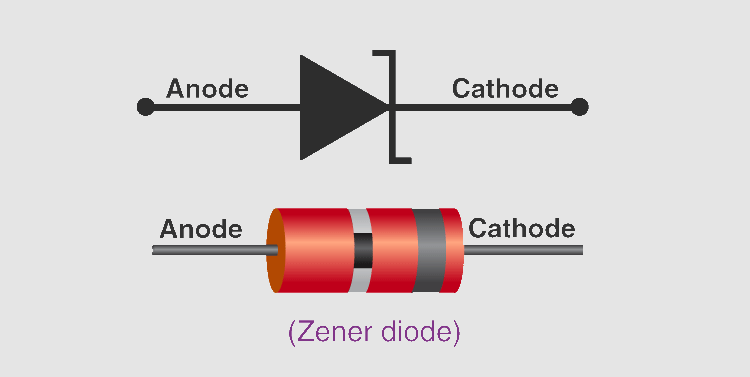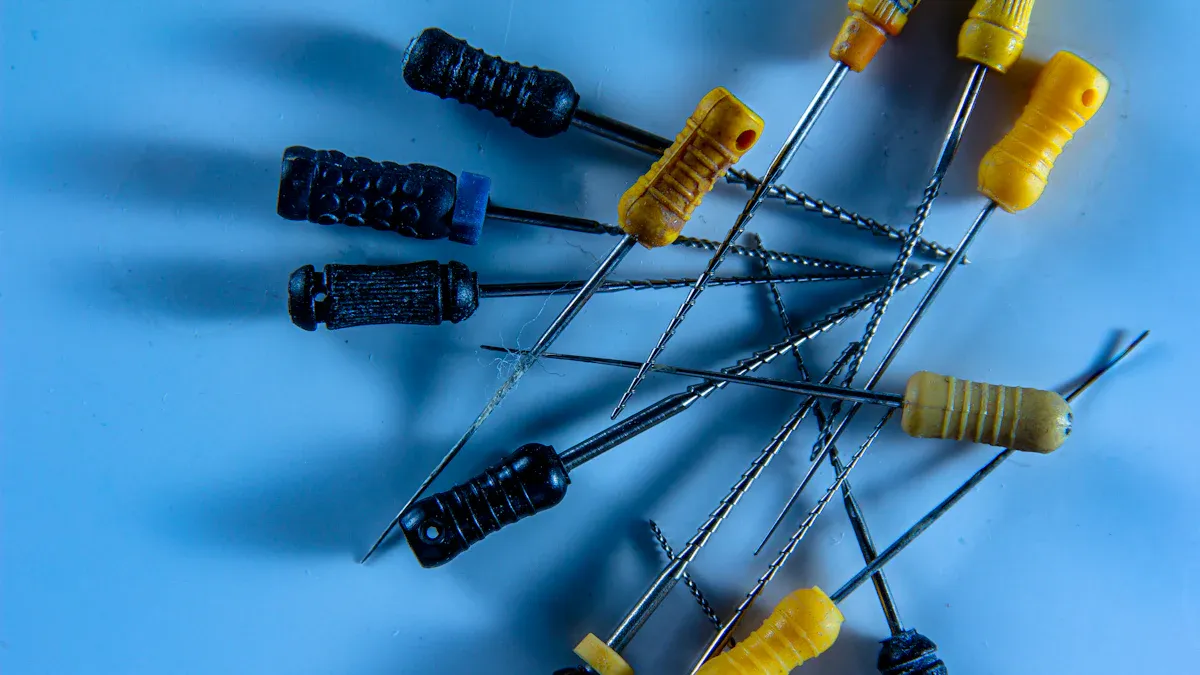
The main difference between a diode and a zener diode lies in their behavior when current flows backward. A regular diode blocks current from flowing backward, while a zener diode allows current to flow backward once a specific voltage threshold is reached. Both the diode and zener diode are made from semiconductor materials and play crucial roles in electronics. The zener diode market was valued at $1.21 billion in 2024, with high demand for zener diodes in electronics and automotive applications.

Key Takeaways
- A diode lets current move in just one way. It keeps circuits safe by stopping current from going backward. A zener diode can let current go backward, but only when voltage gets high enough. This helps keep the voltage at the right level. Diodes are mostly used to change AC to DC. They also help control how much current flows. Zener diodes are used to keep voltage steady. They also protect circuits from sudden voltage jumps. You need to pick a zener diode with the right voltage and power for your circuit. This keeps everything working safely and smoothly. Using zener diodes with resistors helps protect delicate parts. It does this by keeping voltage under control and stopping damage.
Diode Basics
Definition and Operation
A diode is a part made from semiconductor material. It lets electricity flow in only one direction. It has two ends called the anode and the cathode. The anode is the P-side, and the cathode is the N-side. Current can go from the anode to the cathode. It cannot go the other way. This depends on how you connect the voltage.
The table below shows what happens in different situations:
| Characteristic | Forward Bias | Reverse Bias |
|---|---|---|
| Voltage Polarity | Positive voltage to anode (P-side) | Positive voltage to cathode (N-side) |
| Current Flow | Allows significant current flow | Allows only minimal leakage current |
| Barrier Potential | Reduced, enabling current to flow | Increased, preventing current flow |
| Depletion Region | Narrows with increasing voltage | Widens with increasing voltage |
| Diode Behavior | Acts like a closed switch (conductive) | Acts like an open switch (non-conductive) |
| Typical Forward Voltage Drop | Around 0.7 V for silicon diodes | N/A |
A normal diode works like a one-way door for electricity. If the voltage is forward, it lets electricity pass. If the voltage is backward, it stops the flow. This helps protect important parts in a circuit.
Common Uses
Diodes are very important in electronics. They help change AC to DC. They keep circuits safe and can also make light. The table below shows different types of diodes and what they do:
| Diode Type | Primary Function in Electronic Circuits | Example/Application |
|---|---|---|
| Rectifier Diodes | Convert alternating current (AC) to direct current (DC) | Used in power supplies, e.g., laptop chargers converting wall AC to DC |
| Zener Diodes | Regulate voltage by allowing current flow in reverse once a specific voltage is reached | Voltage regulation in mobile phones to protect microprocessors |
| Light-Emitting Diodes (LEDs) | Emit light via electroluminescence when current passes through them | Used in lighting, displays, indicators, e.g., LED bulbs and screens |
| Schottky Diodes | Provide low forward voltage drop and fast switching for high-speed, high-efficiency applications | Used in computer processors for quick data transfer and logic circuits |
| Photodiodes | Detect and convert light into electrical signals | Used in fiber-optic communication and camera sensors for light detection and signal conversion |
Tip: You can find diodes in many things. They are in phone chargers and car headlights. Diodes help keep devices safe and working well.
Some common ways to use diodes are:
-
Power supplies: Rectifier diodes turn AC from the wall into DC.
-
Overvoltage protection: Zener diodes keep voltage safe for small parts.
-
Lighting: LEDs give off bright light in homes and screens.
-
Fast switching: Schottky diodes work in computers and logic circuits.
-
Sensing: Photodiodes find light in cameras and solar panels.
A normal diode is needed to control current. It also protects circuits in electronics and machines.
Zener Diode Basics
Reverse Bias and Zener Effect
A zener diode looks like a regular diode. But it is made in a special way. The makers add a lot of extra material to the semiconductor. This makes a very thin depletion region. Because of this, a strong electric field forms inside the zener diode. When you connect it in reverse bias, it stops current at first. It only lets current flow when the voltage gets high enough. This voltage is called the Zener voltage. At this point, the strong field makes electrons break away from their atoms. This is called the Zener effect.
The Zener effect is a quantum process. It lets electrons move through the barrier in the depletion region. When the reverse voltage hits the Zener voltage, the zener diode starts to let current go backward. The voltage stays almost the same, even if the current changes. Most zener diodes break down between 3.3 volts and 75 volts. Some can handle even higher voltages. The exact voltage depends on how much extra material is added when making the diode.
Note: Zener breakdown happens at lower voltages, usually under 5.6 volts. At higher voltages, avalanche breakdown can also happen.
Voltage Regulation and Protection
The main job of a zener diode is to keep voltage steady. In a circuit, you put the zener diode in reverse bias across the load. If the input voltage goes above the Zener voltage, the zener diode starts to conduct. It keeps the voltage across the load steady. This makes the zener diode important for simple voltage regulators.
A basic voltage regulator uses a zener diode and a resistor. The resistor controls the current. The zener diode keeps the voltage stable. This setup protects small parts like microcontrollers and sensors from voltage spikes. Zener diodes also help with surge protection and waveform clipping. They stop voltage spikes and keep signals from getting too high. This helps protect electronic parts from damage.
| Protection Function | Explanation |
|---|---|
| Surge Protection | The zener diode works when voltage spikes happen. It sends extra voltage away from sensitive parts. |
| Waveform Clipping | It cuts off voltage peaks. This keeps signals safe. |
| Voltage Regulation | It keeps voltage levels steady. This protects circuits from changes in input voltage. |
New zener diode technology uses better materials and designs. These changes make voltage regulation more accurate and reliable. Now, zener diodes work better in small, modern electronic devices.
Diode and Zener Diode Differences

Operation and Direction
The diode and zener diode both help control electricity. They do not work the same way. A diode lets current move in one direction only. It goes from the anode to the cathode. If you try to send current the other way, the diode blocks it. If the voltage gets too high in reverse, the diode can break. The zener diode acts like a normal diode when forward biased. But it has a special skill in reverse bias. When the reverse voltage reaches the Zener voltage, the zener diode lets current flow backward safely. This makes it good for keeping voltage steady.
| Bias Condition | Standard Diode Behavior | Zener Diode Behavior |
|---|---|---|
| Forward Bias | Conducts current after ~0.7 V forward voltage drop | Conducts current similarly with ~0.7 V forward voltage drop |
| Reverse Bias | Blocks current until a high breakdown voltage, then fails | Conducts current at Zener voltage, regulating voltage without damage |
Note: The zener diode can let current go backward at a certain voltage. The diode cannot do this safely.
The way current moves is another big difference. A diode only lets current go one way. The zener diode can let current go both ways, but only at the Zener voltage in reverse.
Doping and Breakdown Voltage
The way companies make the diode and zener diode is not the same. The zener diode has more doping than a regular diode. This makes the depletion region inside the zener diode very thin. Because of this, the breakdown voltage is lower and easy to know. The zener diode can work at this lower voltage without breaking. A regular diode has less doping. Its depletion region is wider. Its breakdown voltage is much higher. If it breaks down, it usually gets damaged.
| Parameter/Aspect | Standard Diode | Zener Diode |
|---|---|---|
| Doping Level | Lightly doped | Heavily doped |
| Depletion Region | Wide | Narrow |
| Breakdown Voltage | High (often around 100V or more) | Low and precise (1.8V to 200V) |
| Breakdown Mechanism | Avalanche breakdown | Zener effect (<5V), avalanche at higher voltages |
The breakdown voltage is very important when picking a diode or zener diode. The zener diode has a low and exact breakdown voltage. This is why it is good for voltage regulation. The regular diode has a high breakdown voltage. It is not good for this job.
Applications Comparison
Because they work differently, they are used for different things. A diode is used to change AC to DC. It also keeps circuits safe by blocking extra current. The zener diode is made to keep voltage steady and protect parts. It helps power supplies give a steady voltage. It also keeps sensitive parts safe from voltage spikes.
| Diode Type | Typical Breakdown Voltage Range | Main Use Cases |
|---|---|---|
| Standard Diode | Around 100V | Rectification, signal control, circuit protection |
| Zener Diode | 1.8V to 200V | Voltage regulation, voltage reference, surge protection |
Some ways people use zener diodes are:
-
Voltage stabilization: Keeps voltage steady even if input changes.
-
Voltage clamping: Stops voltage from getting too high for small parts.
-
Waveform clipping: Cuts off high voltage peaks to protect circuits.
-
Surge protection: Sends away sudden voltage spikes from important parts.
Tip: Zener diodes are small and cheap. They are easy to use in new electronics. They work best in low-power circuits that need steady voltage.
A zener diode is a simple and cheap way to control voltage. But it cannot handle lots of power. Sometimes it needs extra parts to work better. A regular diode is stronger for basic current control and changing AC to DC.
Comparison Table: Key Differences Between Diode and Zener Diode
| Feature | Standard Diode | Zener Diode |
|---|---|---|
| Operation | Conducts in forward bias only | Conducts in forward and reverse (at Zener voltage) |
| Directionality | Uni-directional | Bi-directional (at breakdown voltage) |
| Doping | Light | Heavy |
| Breakdown Voltage | High, not precise | Low, precise, designed for regulation |
| Typical Applications | Rectification, signal control | Voltage regulation, surge protection |
The diode and zener diode are both important in electronics. Their differences in how they work, how they are made, and their breakdown voltage decide where they are used. The zener diode can let current go backward at a set voltage. This makes it great for voltage regulation and protection. The regular diode is best for changing AC to DC and basic current control.
Zener Diode Uses
When to Choose Zener Diode
Engineers pick a zener diode when a circuit needs steady voltage. The zener diode is good for voltage control and protection. It helps keep voltage stable and stops sudden spikes. It is also used as a reference in voltage regulators. Picking the right zener diode means following some steps:
-
Pick a zener voltage that matches the voltage you want.
-
Make sure the zener diode does not get too hot.
-
Use a heat sink if the diode will handle lots of power.
-
Keep the leads short to stop voltage spikes.
-
Test the circuit to see if it works right.
| Selection Criteria | Description |
|---|---|
| Zener Voltage (Vz) | Pick a value close to the voltage you need. |
| Power Dissipation (Pd) | Make sure the diode can handle the power (Pd = Vz × Iz). |
| Tolerance | Choose a small tolerance for circuits that need accuracy. |
| Temperature Coefficient | Pick a low value so voltage stays steady when it gets hot or cold. |
| Dynamic Impedance (Zz) | Lower impedance helps keep voltage steady. |
| Package Type | The size of the diode affects how much heat it can handle. |
| Max Reverse Current | Make sure the diode can handle the current without breaking. |
A zener diode rated at 1 watt can control voltage in small circuits. For more power, engineers use bigger diodes or add heat sinks.
Tip: Always use a resistor with a zener diode. This keeps too much current from hurting the diode.
Practical Circuit Examples
Zener diodes are great when you need steady voltage. In a simple circuit, a zener diode goes in reverse across the load. If the supply voltage goes above the zener voltage, the diode starts to work. It keeps the voltage safe for other parts.
One example uses a 9.1V zener diode to power a radio in a car. The zener diode keeps the voltage at 9V, even if the car battery changes from 12V to 14V. Regular diodes cannot do this because they do not have controlled breakdown.
Zener diodes are also used as voltage references in converters and measuring tools. They keep voltage steady even if the load changes. This makes them good for circuits that need accuracy. In voltage clamping circuits, a zener diode stops voltage from going too high. This protects microcontrollers and sensors from too much voltage.
For surge protection, engineers sometimes use two zener diodes back-to-back. This helps protect against sudden AC voltage spikes. Avalanche diodes are used for bigger surges, but zener diodes work well for low-voltage and precise control.
Note: Always check the datasheet for power ratings. Use a resistor to keep current safe for the zener diode.
The biggest differences between diodes and Zener diodes are how they let current move, how they work when the voltage is reversed, and if they can keep voltage steady.
| Parameter | Diode | Zener Diode |
|---|---|---|
| Current Direction | Uni-directional | Bi-directional |
| Reverse Bias Operation | Damaged if reversed | Operates safely in reverse |
| Voltage Regulation | No | Yes |
| Typical Applications | Rectification, switching | Voltage regulation, protection |
-
Use a regular diode if you need to change AC to DC or turn current on and off.
-
Pick a Zener diode if you want to keep voltage steady or stop too much voltage.
-
Make sure the diode’s voltage and power ratings fit your circuit.
-
Do not use a Zener diode as a normal diode or you will not use its special features.
People who design circuits should think about what each diode can do. This helps keep circuits safe and working well.
FAQ
What is the main job of a Zener diode?
A Zener diode helps keep voltage steady in a circuit. It lets current go backward if voltage gets too high. This protects sensitive parts from sudden voltage spikes.
Can a regular diode work as a voltage regulator?
A regular diode cannot keep voltage steady in a circuit. It only lets current move in one direction. It does not control voltage in reverse like a Zener diode.
Why do engineers use Zener diodes for protection?
Zener diodes help protect circuits from high voltage. They start working when voltage gets too high. This keeps other parts safe from harm.
How does a Zener diode differ from an LED?
| Feature | Zener Diode | LED |
|---|---|---|
| Main Function | Voltage regulation | Light emission |
| Reverse Bias | Yes (at set voltage) | No |
An LED makes light when it works. A Zener diode keeps voltage under control.
Do Zener diodes work in both directions?
Zener diodes act like regular diodes in forward bias. In reverse, they only work when voltage hits the Zener value. They do not work like normal diodes in both directions.
Written by Jack Elliott from AIChipLink.
AIChipLink, one of the fastest-growing global independent electronic components distributors in the world, offers millions of products from thousands of manufacturers, and many of our in-stock parts is available to ship same day.
We mainly source and distribute integrated circuit (IC) products of brands such as Broadcom, Microchip, Texas Instruments, Infineon, NXP, Analog Devices, Qualcomm, Intel, etc., which are widely used in communication & network, telecom, industrial control, new energy and automotive electronics.
Empowered by AI, Linked to the Future. Get started on AIChipLink.com and submit your RFQ online today!













